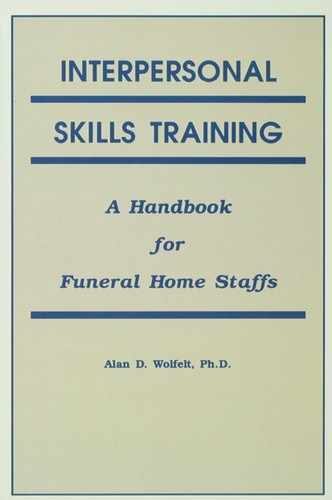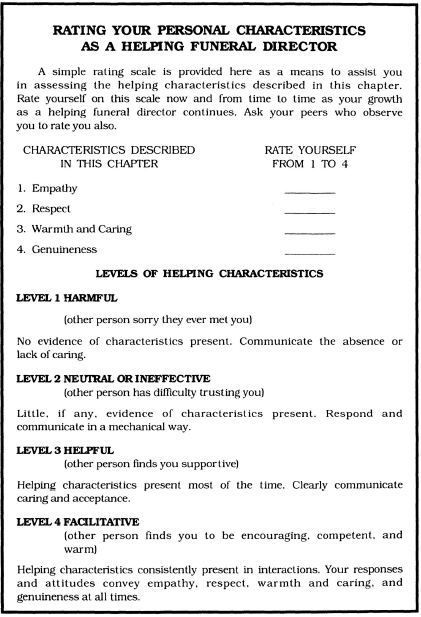CHARACTERISTICS OF THE HELPING FUNERAL DIRECTOR
“Look at people: recognize them, accept them as they are. without wanting to change them.”
Helen Beginton
What personal characteristics make some funeral directors more helpful than others? We have probably all observed some funeral directors with bereaved family members who we can describe as being what we might term “natural helpers.” What may seem natural are more probably characteristics and qualities that have been learned and developed over time. You, too, have the capacity to learn and make use of these helping qualities.
A general principle among people helpers is the following: if you want to became more helpful to others, you must begin with yourself. Our personalities form the basis upon which this helping process is built. The term “self as instrument” has been used in describing the person’s essential helping tool as being oneself and acting spontaneously in response to the rapidly changing interpersonal demands of the helping relationship. In working with families following the death of someone loved, certainly rapidly changing interpersonal demands are placed on the funeral director.
We could review extensive research on personal characteristics of helpers. This would, however, probably leave us feeling overwhelmed, and we might begin to wonder if the “self-actualized” helping funeral director (those who have achieved self-understanding and fulfillment) exists out in the real world! As a consequence, our needs will be better served by expanding on those four qualities—empathy, respect, warmth and caring, and genuineness—most critical to the helping funeral director. However, for those of you wanting a more comprehensive review of general helper characteristics, a review is provided toward the end of this chapter.
To aid in the application of this material to your role as a helper within funeral service, make use of the activities at the conclusion of each characteristic. You then will be able to monitor yourself and receive feedback from others on whether you possess the characteristic described, whether it assists you in your helping efforts, or whether it needs continued work and refinement. Use the rating scale in Figure 3.1 to help you with this task.
Description: The ability to perceive another’s experience and communicate that perception back to the person. As a helping funeral director, I listen to you as you speak to me, and though I cannot experience your experience, I begin to have a mental picture of the essence of what you are describing.
Discussion: Perhaps the most vital part of this characteristic is the ability to convey accurate empathy. Empathetic responsiveness requires the ability to go beyond factual detail and to become involved in the other person’s feeling world, but always with the “as if quality of taking another’s role without personally experiencing what the other person experiences. If you experienced the same emotions as the person you are trying to help, you would be over involved. To have empathy for another person does not constitute the direct expression of one’s own feelings, but rather focuses exclusively on the feelings expressed by another, and thereby conveys an understanding of them.
Figure 3.1 Rating scale for personal characteristics.
The dimension of empathy is communicated when the family member feels the funeral home staff “understands.” As you know, to say simply “I understand how you feel” is not enough. The dimension of empathy is communicated when the funeral home staff is able to respond at the emotional level with the family. The response goes beyond the “I understand how you feel” level to the “You really are feeling a sense of loss” level. In other words, empathy is communicated both verbally and nonverbally by understanding the person at the feeling or emotional level. You reach the family where they are right now, and the result is a feeling on their parts that you understand.
SELF-RATING ON EMPATHY
Directions
How do you rate yourself right now on the helping characteristic of empathy? ________ (Use Level 1 through 4)
Write any Notes or Questions you have on Empathy:
Description: The helping funeral director’s ability to communicate his or her sincere belief that everyone possesses the inherent capacity and right to choose alternatives and make decisions.
Discussion: Respect requires a nonpossessive caring for and affirmation of another person, respecting another’s right to be who and what they are. This quality involves a receptive attitude that embraces the other person’s feelings, opinions, and uniqueness. The respectful, helping funeral director conveys a commitment to understand the person’s feelings and opinions, even when those feelings and opinions are different than his or her own.
So, the dimension of respect is communicated when the family feels they have been allowed to make decisions without being pressured and when their opinions have been considered important. Respect grows out of an attitude on the part of the funeral home staff member that, “Other people know what is best for them better than I do.” A sensitivity to other people which allows them to be themselves in a relationship will enable the family to feel that the funeral home staff respects them. Remembering what the person has said, demonstrating sensitivity and courtesy, and showing respect for the person’s feelings and beliefs are the essences of communicating respect.
SELF-RATING ON RESPECT
Directions
How do you rate yourself right now in the helping characteristic of respect? __________ (Use Level 1 through 4)
Write any Notes or Questions you have on Respect:
Description: The ability to be considerate and friendly as demonstrated by both verbal and nonverbal behaviors.
Discussion: Warmth and caring in the helping funeral director is demonstrated through a sense of personal closeness, as opposed to professional distance. Showing you are warm and caring is particularly helpful in the early phases of building a helping relationship. In addition, during a time of crisis (death obviously being such a time), the supportive value of warmth and caring is especially helpful.
The dimension of warmth is communicated primarily nonverbally. This is everything that influences the people around you other than the words used. For example, in the funeral home, touch is one of the most important nonverbal behaviors, though many others should be taken into consideration.
Warmth is a very powerful dimension in the helping process; in fact, when a discrepancy exists between verbal and nonverbal behavior, people almost always believe the nonverbal. A person’s nonverbal behavior seldom lies. Consequently, a person who has excellent verbal communication skills, but lacks “warm” nonverbal behavior, would more than likely be perceived by the family as not helpful, indifferent, cold, uncaring, or some other negative label. As you will see in the chapter on attending skills, the warmth and caring dimension includes such things as eye contact, tone of voice, dress, physical distance, and gestures.
SELF-RATING ON WARMTH AND CARING
Directions
How do you rate yourself right now on the helping characteristic of warmth and caring? ___ (Use Level 1 through 4)
Write any Notes or Questions you have on Warmth and Caring:
Description: The ability to present oneself sincerely. As a helping funeral director, this is your ability to be freely yourself — nonphoniness, nonrole-playing, nondefensive. It’s when your outer words and behavior match your inner feelings.
Discussion: The dimension of genuineness involves disclosing how you feel about an issue. One important point to remember: try not to tell others how you feel too early. That is, your opinion may interfere with their ability to make a decision. How many times are you confronted by someone you don’t know too well saying, “Here’s what I think you should do …,” or “My impression is …,” or “You should’nt do …” The point is that genuineness can be very helpful, but timing is important. The family’s feelings should be explored first, followed by genuineness on the part of the funeral home staff. This is not to say that staff should be phoney, but rather they should be non-judgmental. This attitude will lead to a feeling by the family that the staff cares about them as individuals. You can earn the right to be genuine with others through first developing the relationship.
SELF-RATING ON GENUINENESS
Directions
How do you rate yourself right now on the helping characteristic of genuineness? ______ (Use Level 1 through 4)
Write any Notes or Questions you have on Genuineness:
A BRIEF REVIEW OF HELPER CHARACTERISTICS
In reviewing the research on general helper characteristics, the following has been discovered.
Rogers (1958) believed that helpers must be open and the following conditions are necessary for helpee’s (the person you are attempting to help) development in a helping relationship.
1. Unconditional Positive Regard: Helpers should communicate acceptance of helpees as worthwhile people, regardless of who they are or what they say or do.
2. Congruence: Helpers should demonstrate congruence between their sayings and behaviors. In other words, they should practice what they preach.
3. Genuineness: Helpers should be genuine and sincere, honest and clear.
4. Empathy: Helpers should be able to communicate empathetic understanding of helpee’s frames of reference and should let them know they feel and understand the helpee’s concerns.
Carkhuff and Truax (1967) developed Rogers’ theoretical formulations into applied research and identified four core dimensions that facilitate effective helping relationships if communicated at high levels. They demonstrated that paraprofessionals as well as professionals can receive training to increase their levels of communication of these four dimensions. This increased communications ability has positive effects on the helpee’s development and capacity to cope with life events. The dimensions are as follows:
1. Empathy: Helpers are able to communicate to the helpee their own self-awareness and understanding in relation to the helpee.
2. Respect and Positive Regard: Helpers can communicate their own warmth and caring.
3. Genuineness: Helpers can be honest with themselves and their helpees.
4. Concreteness: Helpers can be accurate, clear, specific, and immediate in their responses to helpee statements.
Combs et al. (1969) found in their research that effective helpers share certain beliefs about the following:
1. Knowledge: For effective helping to occur, helpers must be personally committed to specialized knowledge in their field and must find this knowledge personally meaningful.
2. People: People are viewed as able rather than unable, worthy rather than unworthy, internally rather than externally motivated, dependable rather than undependable, helped rather than hindered.
3. Self-concept: Helper’s self-concept involves feeling personally adequate rather than inadequate, identifying with rather than apart from others, feeling trustworthy rather than untrustworthy, feeling wanted rather than unwanted, feeling worthy rather than unworthy.
4. Helping Purposes: Helpers are freeing rather than controlling people, deal with larger rather than smaller issues, are more self-revealing than self-concealing, are more involved with than alienated from helpees, are more process oriented than goal oriented in helping relationships.
5. Approaches to Helping: Helpers are more directed toward people than things, are more likely to approach helpees subjectively or phenomenologically than objectively or factually.
Brammer (1983) believed that the following characteristics are necessary in a helping relationship:
1. Self-awareness: Helpers should be aware of their own values and feelings, of the use (and power) of their ability to function as models for helpees.
2. Interest: Helpers should show interest in people and in social change.
3. Ethical Behavior: Helpers should demonstrate commitment to behaviors that are reflections of their own moral standards, of society’s codes, and of the norms of the helping profession.
After reading and participating in the training related to this chapter you should (1) describe four personal characteristics essential to the “helping funeral director”; (2) rate yourself on each of these characteristics; and (3) be familiar with Rogers, Carkhuff and Turax, Combs, and Brammers theoretical and research-based essential helper characteristics.
Brammer, L. (1983). The helping relationship. Englewood Cliffs. NJ: Prentice-Hall.
Carkhuff, R., & Truax. C. (1967). Beyond counseling and therapy. New York: Holt, Rinehart, & Winston.
Combs, A., et al. (1969). Florida studies in the helping professions. Gainesville: University of Florida Press.
Rogers, C. (1958). The characteristics of a helping relationship. Personnel and Guidance Journal (37) 6-16.

